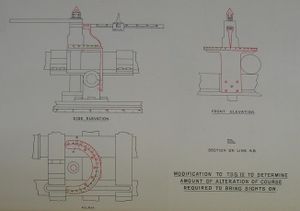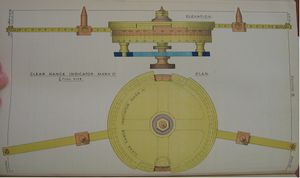Clear Range Indicator

The Clear Range Indicator was a British torpedo-control instrument developed in a series of Marks.
Two designs, which appear to be those of Marks I and II, were discussed in the Annual Report of the Torpedo School, 1916.[2]
These were supplied to "all modern ships" by the end of 1917. One was apparently fitted to the holding down ring of the Torpedo Deflection Sight Mark II, and a third type was added to the spindle of the T.D.S. Mark III, an arrangement that was found to be more compact and convenient.[3] Even the Spartan T.D.S. Mark VI had one.
Mark I
This original model was for use in conning towers.[4] It appears that it was separate from the director or sight, and had a graduated disc that could allow the gyro angle to be read off.[5]
Mark II
This model was for use with Torpedo Deflection Sight Mark II.[6]
Mark III
This model was for use with Torpedo Deflection Sight Mark III and could also help determine how much of a course alteration would be required to bring the sights on.[7]
Mark IV

Probably created in 1918 or so, this was a new model was for use in conning towers with restricted arcs. It could serve the functions of the previous Marks but also show "the arcs between which torpedoes can be fired in connection with the restricted arcs of 70 degrees to 110 degrees" as well as the torpedo gyro angles corresponding to those limits.[9]
Design
A fixed base plate graduated in degrees on each side of the beam up to 60 degrees was placed on a stand atop its three legs, secured by a central screw. A milled wheel could rotate a ring graduated in gyro compass bearings to the own ship's current heading. The 60 degree figure was capable of accommodating torpedo tube angles up to 20 degrees from the beam and a maximum 40 degree gyro angle.
Above this ring were two plates overlapping the edge of the gyro compass ring, each with an arm. The first is graduated in speed of torpedo and has an index permitting its position to be read against the base plate. The second arm was marked in speed of own fleet. The trucks for reading these scales were equipped with sight pointers sticking upward. Both plates were "cut away on the edge over angles of 70 to 110 degrees from the line of the graduated arm." The central pivot acted, in addition to the pointers on the torpedo and fleet arms, as a third sighting element.[10]
Use to Clear Range Indicator
The torpedo speed would be set on the torpedo arm, and the speed of the fastest ship in one's own fleet set upon the own fleet arm. The torpedo arm would be rotated to the graduation on the base plate along which the torpedo was to run and the "own fleet" bar oriented to parallel the course of the friendly ship. The user would then sight between the torpedo arm and own fleet arm pointers, and "if friendly ship is on the torpedo bar side of the line of sight she is foul".[11]
Use to Indicate Clear Arcs
The device could also serve indicate clear arcs from 70 to 110 degrees and their corresponding gyro angles. The user would point one bar at a friendly ship on the quarter, using the central pivot bar and the pointer on that arm. The second arm would be similarly pointed at a friendly ship on the bow. The milled knob would then be used to turn the gyro bearing rin to the ship's head arrow on the after side of the instrument (two ship's head arrows were provided so the device could work for either port or starboard). Note where the gaps in the arm plates do not obscure the gyro bearing ring; these values indicate the clear gyro bearings. Looking below these values to the base plate scale indicates the angles from the beam on which torpedoes may be fired.[12]
See Also
Footnotes
- ↑ Annual Report of the Torpedo School, 1918, Plate 108.
- ↑ Annual Report of the Torpedo School, 1916, p. 27. (T.O. 39/1916)
- ↑ Annual Report of the Torpedo School, 1917, p. 195.
- ↑ Annual Report of the Torpedo School, 1918, p. 165.
- ↑ Annual Report of the Torpedo School, 1916, p. 27.
- ↑ Annual Report of the Torpedo School, 1918, p. 165.
- ↑ Annual Report of the Torpedo School, 1918, p. 165.
- ↑ Annual Report of the Torpedo School, 1918, Plate 117.
- ↑ Annual Report of the Torpedo School, 1918, p. 165.
- ↑ Annual Report of the Torpedo School, 1918, p. 166.
- ↑ Annual Report of the Torpedo School, 1918, p. 166. The editor is not sure he understands the last quoted sentence.
- ↑ Annual Report of the Torpedo School, 1918, p. 166. The editor is not sure he understands this functionality.
Bibliography
- Admiralty, Gunnery Branch (1917). Handbook of Torpedo Control, 1916. C.B. 302. Copy No. 141 at The National Archives. ADM 186/381.
- H.M.S. Vernon. Annual Report of the Torpedo School, 1917. Originally C.B. 1474. Copy 7 at The National Archives. ADM 189/37.
- H.M.S. Vernon. Annual Report of the Torpedo School, 1918. C.B. 1527. Copy 143 at The National Archives. ADM 189/38.